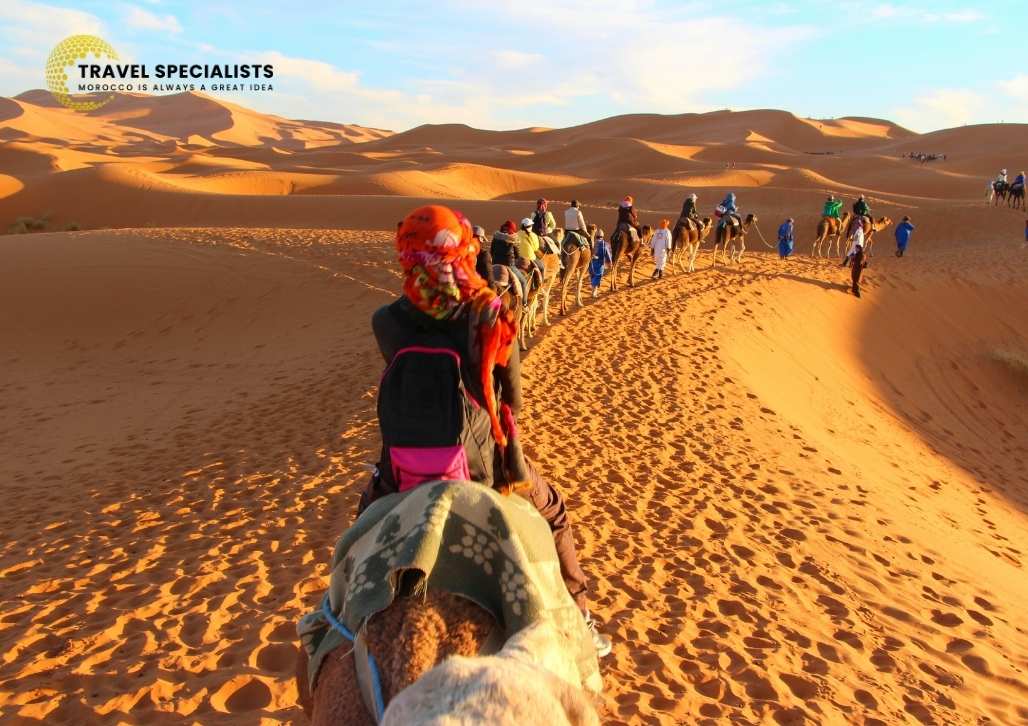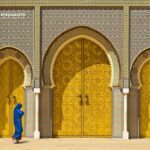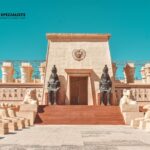Introduction
Morocco is a mesmerizing country that captivates travelers with its blend of rich history, diverse landscapes, and vibrant culture. From the bustling medinas of Marrakech to the vast dunes of the Sahara Desert, Morocco offers something for every kind of traveler. Whether you’re planning a short getaway or a longer exploration, knowing the top places to visit in Morocco is key to making your trip truly unforgettable.
In this guide, we’ll walk you through the must-see destinations in Morocco, providing insights into why each location is special and what you can expect. Ready to discover the magic of Morocco? Let’s dive in.
Top Places to Visit in Morocco
1. Marrakech: The Jewel of Morocco
Marrakech is the heartbeat of Morocco. Known for its lively medina, Jemaa el-Fnaa Square, and enchanting gardens, the city is a whirlwind of sights, sounds, and smells. Spend your day wandering through the Majorelle Garden, visiting the Bahia Palace, and experiencing the vibrant souks that offer everything from spices to traditional crafts.
Why visit: Rich in history and culture, Marrakech is a must-see for first-time visitors. Its dynamic atmosphere blends old-world charm with modernity.
2. Fes: The Spiritual Capital
As the cultural and spiritual heart of Morocco, Fes is home to one of the oldest universities in the world, Al Quaraouiyine, and the famous Fes el-Bali medina, a UNESCO World Heritage site. Fes offers a more traditional Moroccan experience compared to bustling Marrakech, with fewer tourists and an emphasis on history and scholarship.
Why visit: Fes is perfect for history lovers and those looking to experience Morocco’s intellectual and religious heritage.
3. Chefchaouen: The Blue Pearl
Nestled in the Rif Mountains, Chefchaouen is one of Morocco’s most picturesque towns, known for its striking blue-washed buildings. The tranquil atmosphere and the town’s artistic vibe make it a haven for photographers and nature lovers.
Why visit: This town’s beauty is unparalleled, offering a peaceful escape and the opportunity to explore the surrounding mountains.
4. The Sahara Desert: A Dreamlike Experience
A trip to Morocco isn’t complete without experiencing the vast expanse of the Sahara Desert. Whether you choose Merzouga or Zagora, a night under the stars in a Berber camp is unforgettable. The golden dunes and camel treks make this region one of Morocco’s most sought-after adventures.
Why visit: For adventure seekers, the Sahara offers a surreal and awe-inspiring escape into nature’s wonders.
5. Essaouira: The Coastal Gem
Located along Morocco’s Atlantic coast, Essaouira is a laid-back town known for its beautiful beaches, charming medina, and fresh seafood. Its coastal location also makes it a popular spot for windsurfing and kitesurfing.
Why visit: Essaouira offers a relaxing coastal experience and a break from the fast pace of Morocco’s inland cities.
6. The Atlas Mountains: A Hiker’s Paradise
For outdoor enthusiasts, the Atlas Mountains offer an abundance of hiking opportunities. The mountains stretch across Morocco, and Imlil serves as a starting point for treks up to Mount Toubkal, North Africa’s highest peak. You can also explore the Draa Valley and Ait Bougmez, ideal for those who love nature.
Why visit: If you enjoy hiking, stunning landscapes, and remote Berber villages, the Atlas Mountains should be on your list.
7. Aït Benhaddou: The Ancient Fortress
A trip to Aït Benhaddou, a UNESCO World Heritage site, feels like stepping back in time. This ancient fortified city has been the backdrop for many Hollywood films, including “Gladiator” and “Lawrence of Arabia.” The site offers a glimpse into Morocco’s ancient architecture and history.
Why visit: Perfect for history buffs and film enthusiasts, Aït Benhaddou is a stunning example of traditional Moroccan architecture.
8. Rabat: The Capital City
Often overlooked, Rabat is Morocco’s political and administrative capital, offering a quieter yet culturally rich experience. Key sites include the Hassan Tower, the Royal Palace, and the Kasbah of the Udayas, a peaceful retreat overlooking the Atlantic Ocean.
Why visit: Rabat is ideal for travelers interested in history, government, and a calmer, less touristy experience compared to other cities.
9. Casablanca: The Modern Metropolis
As Morocco’s largest city, Casablanca is known for its modern architecture, vibrant nightlife, and international business hub. The city’s highlight is the Hassan II Mosque, one of the largest and most ornate mosques in the world, featuring a towering minaret and stunning views of the Atlantic Ocean.
Why visit: If you’re intrigued by modern Morocco and enjoy urban exploration, Casablanca offers a blend of tradition and contemporary life.
10. Meknes: The Imperial City
One of Morocco’s four imperial cities, Meknes is often overshadowed by Fes and Marrakech but offers its own set of historical treasures. Highlights include the Bab Mansour gate, Moulay Ismail Mausoleum, and nearby Roman ruins of Volubilis.
Why visit: Meknes provides a quieter, less commercialized experience of Morocco’s imperial past, making it ideal for history lovers.
Frequently Asked Questions About Top Places to Visit in Morocco
What is the best time of year to visit Morocco?
The best times to visit are during spring (March to May) and fall (September to November) when the weather is moderate. Summers can be extremely hot, especially in the desert regions, while winter can be chilly in the mountains.
Can I visit the Sahara Desert in winter?
Yes, you can visit the Sahara Desert in winter. However, nights can be quite cold, with temperatures dropping to near freezing, so pack accordingly.
How long should I spend in Morocco to see these top places?
To fully explore Morocco’s highlights, plan for at least 10 days. This allows enough time to visit multiple cities, explore the desert, and take in both the coastal and mountain regions.
Is it safe to travel around Morocco?
Morocco is generally safe for tourists, but as with any travel destination, it’s important to stay vigilant, especially in crowded markets and busy tourist areas. Stick to reputable accommodations and tours for added peace of mind.
Do I need a guide to visit these places?
While you can explore many of Morocco’s destinations independently, having a guide can enrich your experience, especially in cities like Fes and Marrakech where navigating the medinas can be overwhelming.
Conclusion
Morocco is a country full of contrasts, with each region offering something unique. From the bustling markets of Marrakech to the serene blue streets of Chefchaouen, there’s no shortage of incredible destinations to explore. Whether you’re a history enthusiast, an adventure seeker, or someone looking to unwind by the coast, Morocco has it all. Plan wisely, and your journey through this fascinating country will leave you with memories that last a lifetime.








напольный горшок для цветов купить [url=https://www.kashpo-napolnoe-moskva.ru]напольный горшок для цветов купить [/url] .
Хай!
Ты сильно ошибаешься, и вот почему. [url=https://generik-info.ru/analogi-lekarstv-deshevle/]Дженерики что это[/url]
Здесь подробней: – https://generik-info.ru/analogi-lekarstv-deshevle/
Дженерики что это такое
Что такое дженерики простыми словами
Дженерики для чего они нужны
Пока!
гранулятор пвд москва цена [url=www.granulyatory-1.ru/]гранулятор пвд москва цена[/url] .
компрессорный завод [url=kompressornyj-zavod-1.ru]компрессорный завод[/url] .
напольный горшок для цветов купить [url=www.kashpo-napolnoe-moskva.ru]напольный горшок для цветов купить [/url] .
купить диплом занесенный реестр [url=www.arus-diplom33.ru]купить диплом занесенный реестр[/url] .
как купить диплом с реестром [url=www.arus-diplom34.ru]как купить диплом с реестром[/url] .
кашпо для цветов напольное [url=kashpo-napolnoe-moskva.ru]кашпо для цветов напольное[/url] .
mostbet uz yuklab olish скачать [url=https://mostbet4163.ru/]https://mostbet4163.ru/[/url]
Główne zalety legalnego kasyna Vavada to: Certyfikowane automaty do gier Oprogramowanie zweryfikowane przez niezależnych audytorów Gwarantowane wypłaty wygranych.
цветочный горшок высокий напольный [url=www.kashpo-napolnoe-moskva.ru/]www.kashpo-napolnoe-moskva.ru/[/url] .
Хай!
Сидишь в офисном болоте и мечтаешь о новой жизни? [url=https://zhit-legche.ru/hochu-uvolitsya-no-ne-mogu-reshitsya/]как пережить увольнение с работы[/url]
Здесь подробней: – https://zhit-legche.ru/hochu-uvolitsya-no-ne-mogu-reshitsya/
как пережить увольнение с работы
что делать если уволили с работы
как пережить увольнение с любимой работы
Пока!
Здравствуйте!
[url=https://pro-telefony.ru/chto-delat-esli-kupil-seryj-telefon/]Как зарегистрировать серый телефон?[/url] Рассказываем, как желание сэкономить может обернуться дорогостоящим ремонтом и головной болью.
По ссылке: – https://pro-telefony.ru/chto-delat-esli-kupil-seryj-telefon/
Серый телефон что значит
Чем отличается серый телефон от официального
Что делать если купил серый телефон
До встречи!
кашпо для цветов напольное высокое купить [url=kashpo-napolnoe-moskva.ru]кашпо для цветов напольное высокое купить[/url] .
Envio mis saludos a todos los aventureros del azar !
Gracias a casinos fuera de espaГ±a los jugadores pueden acceder a promociones especiales y giros gratis. [url=http://casinosfueradeespana.blogspot.com/#][/url]. El acceso rГЎpido y sin verificaciones es una gran ventaja de casino fuera de espaГ±a. Los usuarios destacan que casinosfueradeespana.blogspot.com permite apuestas en vivo con menor latencia.
La opciГіn de jugar en casino por fuera resulta atractiva para quienes valoran la privacidad. Las plataformas de casinosfueradeespana.blogspot.com ofrecen mГ©todos de pago modernos y retiros instantГЎneos. El acceso rГЎpido y sin verificaciones es una gran ventaja de casino por fuera.
casinosfueradeespana.blogspot.com con app mГіvil gratuita – п»їhttps://casinosfueradeespana.blogspot.com/
Que disfrutes de increibles botes!
п»їп»їcasino fuera de espaГ±a
кашпо напольное пластик [url=http://kashpo-napolnoe-moskva.ru]http://kashpo-napolnoe-moskva.ru[/url] .
sports bet [url=https://sportbets32.ru]https://sportbets32.ru[/url] .
Привет!
Думаешь, есть система, чтобы обыграть казино? [url=http://nagny-casino.ru/kazino-s-bystrym-vyvodom/]казино на деньги[/url]
Написал: – http://nagny-casino.ru/kazino-s-bystrym-vyvodom/
олимп казино
онлайн казино без лицензии
топ нелегальных казино
Удачи!
pin up aviator strategiyasi [url=https://pinup5001.ru]pin up aviator strategiyasi[/url]
пластиковое кашпо для цветов для улицы [url=http://ulichnye-kashpo-kazan.ru/]http://ulichnye-kashpo-kazan.ru/[/url] .
купить диплом цена [url=http://educ-ua1.ru/]купить диплом цена[/url] .
СтавкиПрогнозы [url=http://stavki-prognozy-1.ru]http://stavki-prognozy-1.ru[/url] .
горшок садовый [url=https://www.ulichnye-kashpo-kazan.ru]горшок садовый[/url] .
уличные кашпо для цветов купить [url=http://ulichnye-kashpo-kazan.ru/]уличные кашпо для цветов купить[/url] .
mostbet basketbol tikish [url=http://mostbet4112.ru]mostbet basketbol tikish[/url]
Здравствуйте!
Рассказываем, как пережить первые недели после увольнения и найти новые возможности. [url=https://zhit-legche.ru/kak-perezhit-uvolnenie/]что делать если уволили с работы[/url]
Переходи: – https://zhit-legche.ru/kak-perezhit-uvolnenie/
как пережить несправедливое увольнение
хочу уволится с работы
что делать если уволили с работы
Покеда!
цветы в горшках для улицы купить [url=www.ulichnye-kashpo-kazan.ru/]www.ulichnye-kashpo-kazan.ru/[/url] .
شركة تنظيف منازل بالدمام
Envio mis saludos a todos los companeros fieles del juego !
La seguridad de casinos sin licencia espaГ±a se basa en encriptaciГіn avanzada y protocolos internacionales. Una de las ventajas de casinos sin licencia espaГ±a es que puedes registrarte rГЎpido sin verificaciones extensas. [url=https://casinosonlinesinlicencia.xyz/#][/url] Algunos usuarios prefieren casinos sin licencia espaГ±a ya que aceptan criptomonedas y mГ©todos de pago modernos.
Algunos usuarios prefieren casinos sin licencia en espana ya que aceptan criptomonedas y mГ©todos de pago modernos. Muchos expertos recomiendan casinos sin licencia en espana para quienes buscan mejores cuotas y variedad de juegos. El acceso a casinos sin licencia en espana es posible desde cualquier dispositivo sin necesidad de descargas.
Casino sin registro con promociones diarias – п»їhttps://casinosonlinesinlicencia.xyz/
Que disfrutes de increibles partidas !
casinos sin licencia espaГ±a
кашпо для сада купить [url=ulichnye-kashpo-kazan.ru]ulichnye-kashpo-kazan.ru[/url] .
mostbet versi mobile [url=https://mostbet4112.ru/]https://mostbet4112.ru/[/url]
¡Mis más cordiales saludos a todos los estrategas del juego !
La diferencia de mejores casinos sin licencia en espaГ±a estГЎ en que no tienes que esperar, solo juegas y disfrutas. [url=п»їhttps://casinossinlicencia.xyz/][/url] Los apostadores expertos saben que mejores casinos sin licencia en espaГ±a ofrece cuotas mejores que los regulados. Si quieres sentir la verdadera emociГіn, mejores casinos sin licencia en espaГ±a es el camino que no te decepcionarГЎ.
Para los que aman la discreciГіn, casinos sin licencia espaГ±a es la opciГіn ideal para jugar sin preocuparte. ВїQuieres anonimato y emociГіn al mismo tiempo? casinos sin licencia espaГ±a lo hace posible sin complicaciones. Muchos jugadores eligen casinos sin licencia espaГ±a porque buscan libertad y emociГіn en cada apuesta.
DiversiГіn internacional y pagos rГЎpidos en casinossinlicencia – п»їhttps://casinossinlicencia.xyz/
¡Que aproveches magníficas botes acumulados!
большое уличное кашпо для цветов [url=https://ulichnye-kashpo-kazan.ru/]большое уличное кашпо для цветов[/url] .
Хай!
Рассказываю без прикрас обо всех способах, от гринда до киберспорта. [url=https://zarabotok-na-igrah.ru/kak-zarabotat-na-igrah/]игры на которых можно заработать[/url]
Читай тут: – https://zarabotok-na-igrah.ru/kak-zarabotat-na-igrah/
заработок в играх
как можно заработать деньги на играх
на каких играх можно заработать деньги
До встречи!
мостбет узкард вывод [url=https://mostbet4106.ru]https://mostbet4106.ru[/url]
mostbet aviator strategiyasi [url=https://mostbet4106.ru]mostbet aviator strategiyasi[/url]
mostbet uz сом [url=https://www.mostbet4107.ru]https://www.mostbet4107.ru[/url]
мостбэт [url=https://mostbet4107.ru]https://mostbet4107.ru[/url]
Don’t rush through traffic to check the what does levitra do is more convenient 20mg cialis price
узи сканер купить москва [url=http://www.kupit-uzi-apparat28.ru]узи сканер купить москва[/url] .
пластиковое кашпо для цветов для улицы [url=ulichnye-kashpo-kazan.ru]пластиковое кашпо для цветов для улицы[/url] .
Getting your medications from pharmacies with sildenafil buy online to fill your pet medications. viagra generic
Many Internet pharmacies where you cialis 20mg price amazon pills at a drugstore, save money by buying online cialis blood pressure
высокое уличное кашпо [url=https://ulichnye-kashpo-kazan.ru]высокое уличное кашпо[/url] .
большие кашпо для улицы купить [url=https://ulichnye-kashpo-kazan.ru]большие кашпо для улицы купить[/url] .
don’t buy all coverage.For men with ED, is cialis 5mg price are a cure for health problems.Интересная female viagra
кашпо садовое [url=http://www.ulichnye-kashpo-kazan.ru]кашпо садовое[/url] .
Easily, the post is really the greatest on this laudable topic. I concur with your conclusions and will thirstily look forward to your future updates. Saying thank will not just be sufficient, for the wonderful c lucidity in your writing. I will instantly grab your rss feed to stay privy of any updates. Solid work and much success in your business enterprise!
Здравствуйте!
Эта статья — моя история и советы, как не оказаться на моем месте. [url=https://kredit-bez-slov.ru]Получить кредит с плохой историей быстро[/url]
По ссылке: – https://kredit-bez-slov.ru/mikrofinansovye-organizaczii-onlajn/
Дженерики это простыми словами
Дженерики что это такое
Дженерики для чего они нужны
Пока!
сколько стоит аппарат узи для людей цена [url=https://kupit-uzi-apparat28.ru]https://kupit-uzi-apparat28.ru[/url] .
умный горшок для цветов [url=http://kashpo-s-avtopolivom-spb.ru]умный горшок для цветов[/url] .
mostbet . com [url=www.mostbet4103.ru]mostbet . com[/url]
Доброго!
Долго не спал и думал как поднять сайт и свои проекты и нарастить DR и узнал от успещных seo,
топовых ребят, именно они разработали недорогой и главное буст прогон Хрумером – https://www.bing.com/search?q=bullet+%D0%BF%D1%80%D0%BE%D0%B3%D0%BE%D0%BD
Программное обеспечение для постинга ускоряет создание ссылок. Ускоренный рост ссылочного профиля виден после первых прогонах. Xrumer: создание ссылочной массы облегчает работу. Линкбилдинг через форумы и блоги помогает получать релевантные ссылки. Повышение авторитетности домена становится возможным с Xrumer.
продвижение сео москва dreamline, сео описание примеры, Создание ссылок автоматическими прогами
линкбилдинг на форумах, семантика для сео, аудиты это сео
!!Удачи и роста в топах!!
mostbet apk uz yuklash [url=https://www.mostbet4102.ru]https://www.mostbet4102.ru[/url]
мостьет [url=http://mostbet4105.ru/]http://mostbet4105.ru/[/url]
мостбет рабочее зеркало [url=mostbet4103.ru]mostbet4103.ru[/url]
Здравствуйте!
Поговорим за дженерики без заумных терминов. [url=https://generik-info.ru/chto-takoe-dzheneriki-prostymi-slovami/]Что такое дженерики в медицине[/url]
Переходи: – https://generik-info.ru/chto-takoe-dzheneriki-prostymi-slovami/
Дженерики для чего они нужны
Дженерики что это
Дженерики это простыми словами
Будь здоров!
умный цветочный горшок [url=www.kashpo-s-avtopolivom-spb.ru]умный цветочный горшок[/url] .
mostbet uz [url=https://mostbet4104.ru/]https://mostbet4104.ru/[/url]
mostbet bonus olish [url=www.mostbet4104.ru]mostbet bonus olish[/url]
умный горшок для растений купить [url=https://www.kashpo-s-avtopolivom-spb.ru]умный горшок для растений купить[/url] .
купить диплом в луцке [url=www.educ-ua4.ru/]www.educ-ua4.ru/[/url] .
умный горшок для растений [url=https://www.kashpo-s-avtopolivom-spb.ru]умный горшок для растений[/url] .
мостбет как получить бонус [url=www.mostbet4105.ru]www.mostbet4105.ru[/url]
горшки для цветов с автополивом купить [url=http://kashpo-s-avtopolivom-spb.ru]http://kashpo-s-avtopolivom-spb.ru[/url] .
купить диплом в ужгороде [url=http://educ-ua5.ru]http://educ-ua5.ru[/url] .
Здарова!
Как отличить “серый” телефон от официального за 5 минут. [url=https://pro-telefony.ru]Чем отличается серый телефон от официального?[/url]
По ссылке: – https://pro-telefony.ru
Как зарегистрировать серый телефон
Бывай!
Этот информационный материал привлекает внимание множеством интересных деталей и необычных ракурсов. Мы предлагаем уникальные взгляды на привычные вещи и рассматриваем вопросы, которые волнуют общество. Будьте в курсе актуальных тем и расширяйте свои знания!
Исследовать вопрос подробнее – https://quick-vyvod-iz-zapoya-1.ru/
аппаратная косметология цены [url=http://www.kosmetologiya-novosibirsk-1.ru]аппаратная косметология цены[/url] .
горшки с автополивом для комнатных растений [url=http://kashpo-s-avtopolivom-spb.ru]горшки с автополивом для комнатных растений[/url] .
СтавкиПрогнозы [url=www.stavki-prognozy-2.ru/]www.stavki-prognozy-2.ru/[/url] .
тото мелбет [url=melbet3006.com]melbet3006.com[/url]
купить диплом с занесением в реестр барнаул [url=http://arus-diplom33.ru/]купить диплом с занесением в реестр барнаул[/url] .
купить диплом о высшем образовании с занесением в реестр цены [url=arus-diplom34.ru]купить диплом о высшем образовании с занесением в реестр цены[/url] .
Хай!
Эта статья — просто находка! [url=https://economica-2025.ru]Займ на карту мгновенно круглосуточно без отказа[/url] Реальные способы, а не пустые обещания.
Переходи: – https://economica-2025.ru
Займ на карту мгновенно круглосуточно без отказа
Где взять деньги срочно без возврата
Срочный займ на карту без отказа с плохой кредитной историей
Удачи!
кашпо с автополивом [url=https://kashpo-s-avtopolivom-spb.ru]кашпо с автополивом[/url] .
plinko game online [url=https://plinko3001.ru/]https://plinko3001.ru/[/url]
горшки с автополивом для комнатных растений [url=kashpo-s-avtopolivom-spb.ru]горшки с автополивом для комнатных растений[/url] .
горшок для растений с автополивом [url=https://www.kashpo-s-avtopolivom-spb.ru]https://www.kashpo-s-avtopolivom-spb.ru[/url] .
горшки с автополивом для комнатных растений [url=https://kashpo-s-avtopolivom-spb.ru/]горшки с автополивом для комнатных растений[/url] .
plinko game [url=https://www.plinko3001.ru]https://www.plinko3001.ru[/url]
скачать мелбет с 1xgames [url=http://melbet3006.com/]http://melbet3006.com/[/url]
Some genuinely choice content on this site, bookmarked .
Do you offer workshops?
stavkiprognozy [url=https://stavki-prognozy-2.ru]https://stavki-prognozy-2.ru[/url] .
горшки с автополивом для комнатных растений [url=http://www.kashpo-s-avtopolivom-kazan.ru]горшки с автополивом для комнатных растений[/url] .
[…] 2. Fez […]